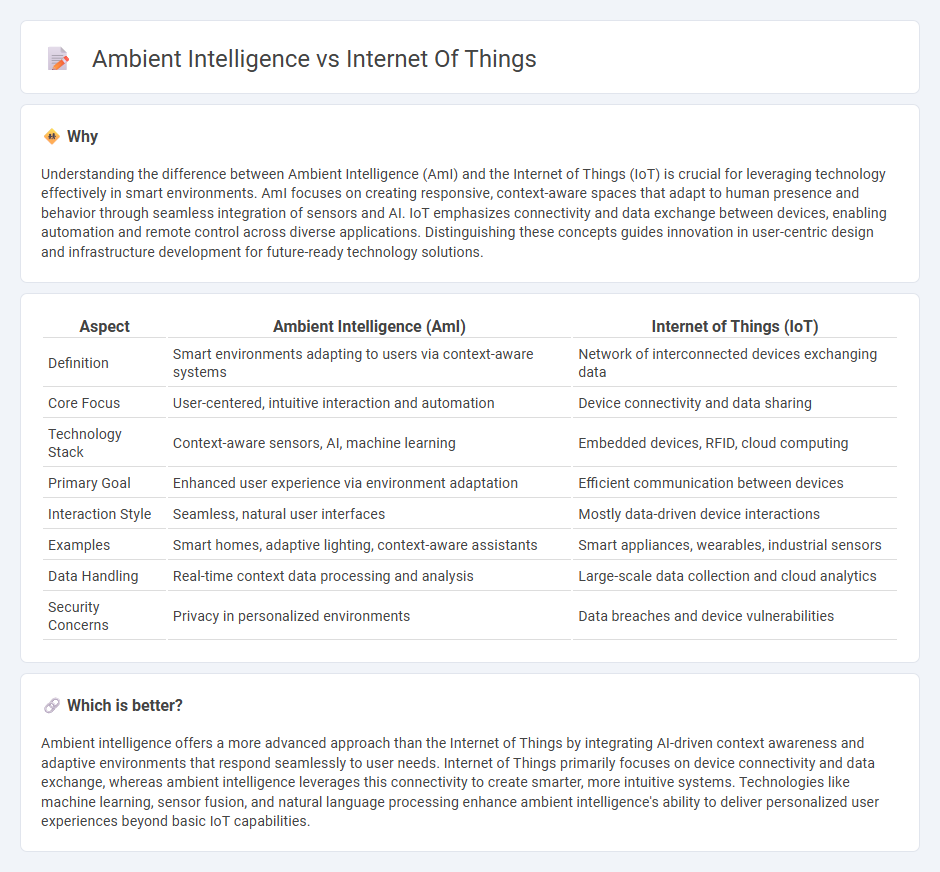
Ambient intelligence integrates sensors, artificial intelligence, and human-centric design to create responsive environments that adapt seamlessly to user needs. The Internet of Things (IoT) connects physical devices and systems via the internet, enabling data exchange and remote control across diverse applications. Explore the differences and synergies between Ambient Intelligence and IoT to understand their impact on smart technology development.
Why it is important
Understanding the difference between Ambient Intelligence (AmI) and the Internet of Things (IoT) is crucial for leveraging technology effectively in smart environments. AmI focuses on creating responsive, context-aware spaces that adapt to human presence and behavior through seamless integration of sensors and AI. IoT emphasizes connectivity and data exchange between devices, enabling automation and remote control across diverse applications. Distinguishing these concepts guides innovation in user-centric design and infrastructure development for future-ready technology solutions.
Comparison Table
| Aspect | Ambient Intelligence (AmI) | Internet of Things (IoT) |
|---|---|---|
| Definition | Smart environments adapting to users via context-aware systems | Network of interconnected devices exchanging data |
| Core Focus | User-centered, intuitive interaction and automation | Device connectivity and data sharing |
| Technology Stack | Context-aware sensors, AI, machine learning | Embedded devices, RFID, cloud computing |
| Primary Goal | Enhanced user experience via environment adaptation | Efficient communication between devices |
| Interaction Style | Seamless, natural user interfaces | Mostly data-driven device interactions |
| Examples | Smart homes, adaptive lighting, context-aware assistants | Smart appliances, wearables, industrial sensors |
| Data Handling | Real-time context data processing and analysis | Large-scale data collection and cloud analytics |
| Security Concerns | Privacy in personalized environments | Data breaches and device vulnerabilities |
Which is better?
Ambient intelligence offers a more advanced approach than the Internet of Things by integrating AI-driven context awareness and adaptive environments that respond seamlessly to user needs. Internet of Things primarily focuses on device connectivity and data exchange, whereas ambient intelligence leverages this connectivity to create smarter, more intuitive systems. Technologies like machine learning, sensor fusion, and natural language processing enhance ambient intelligence's ability to deliver personalized user experiences beyond basic IoT capabilities.
Connection
Ambient intelligence leverages Internet of Things (IoT) technology by embedding interconnected smart devices within environments to create responsive and adaptive systems. IoT sensors collect real-time data that ambient intelligence uses to analyze context and automate decision-making processes seamlessly. This integration enhances user experiences through personalized, intuitive interactions in smart homes, cities, and workplaces.
Key Terms
**Internet of Things:**
Internet of Things (IoT) connects billions of devices through the internet, enabling seamless data exchange for smart homes, wearable technology, and industrial automation. IoT's real-time monitoring and predictive analytics optimize operations by enhancing efficiency and reducing downtime. Explore comprehensive insights on how IoT transforms digital ecosystems and drives innovation.
Sensors
Sensors in the Internet of Things (IoT) collect real-time data from interconnected devices, enabling automation and remote monitoring across various industries. Ambient intelligence leverages advanced sensors to create environments that adapt dynamically to human presence and behavior, enhancing user experience through context-aware interactions. Explore further to understand how these sensor technologies transform smart environments and drive innovation.
Connectivity
Internet of Things (IoT) emphasizes widespread device connectivity enabling seamless data exchange across sensors, actuators, and networks to create intelligent environments. Ambient intelligence (AmI) builds on IoT by integrating context-aware systems that adapt autonomously to user needs through enhanced inter-device communication and real-time data processing. Explore deeper insights into how connectivity shapes these transformative technologies.
Source and External Links
What Is the Internet of Things? - The Internet of Things (IoT) network includes physical objects embedded with sensors and software to connect and exchange data over the internet.
What is the Internet of Things (IoT)? - IoT refers to a network of devices, vehicles, and objects with sensors and software, enabling data collection and sharing across various industries.
What is IoT? - Internet of Things Explained - IoT connects devices and facilitates communication between them and the cloud, integrating everyday objects with the internet using sensors and processors.
 dowidth.com
dowidth.com